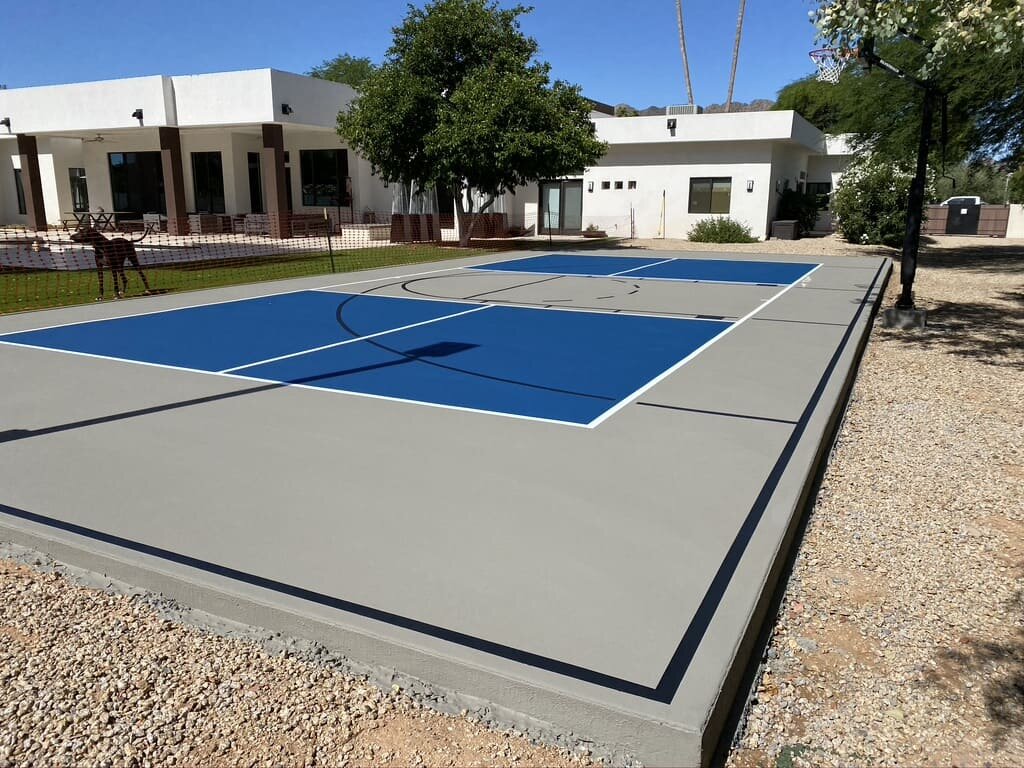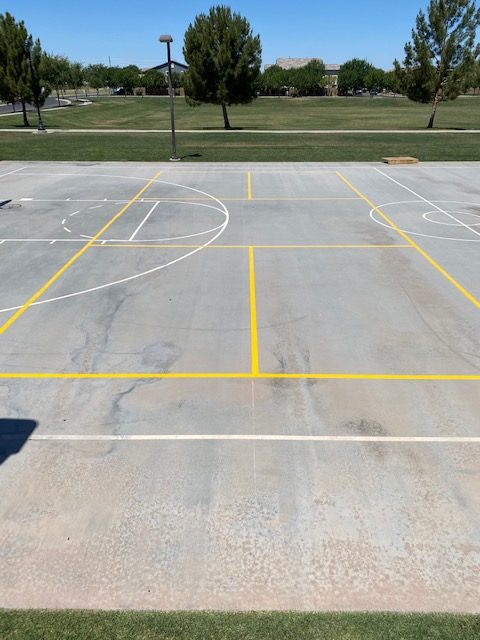A Comprehensive Overview to Creating the Perfect Pickleball Court for All Skill Degrees
Creating a pickleball court that satisfies gamers of differing ability levels demands a multifaceted technique, encompassing vital components such as court dimensions, surface area materials, and access features. The equilibrium in between functionality and security is extremely important, as is the creation of a welcoming atmosphere for both viewers and participants. With the ideal layout selections, one can foster an appealing ambience that advertises enjoyment and skill advancement. Pickleball court contractor. The details entailed in achieving this balance are frequently neglected. What particular factors to consider must be focused on to guarantee a successful application?

Understanding Court Capacities
Recognizing the dimensions of a pickleball court is essential for both players and developers, as these requirements guarantee a fair and consistent having fun experience. A typical pickleball court gauges 20 feet broad by 44 feet long for both songs and doubles play. The court is divided right into two equivalent halves by a web that stands 36 inches high at the sidelines and 34 inches at the facility.
Key attributes of the court include the non-volley area, frequently referred to as the "kitchen area," which extends 7 feet from the internet on both sides. This area is important for managing player motion and volleying, ensuring calculated play. Furthermore, the service areas on each side of the court are vital, measuring 10 feet vast and 15 feet deep, developed to suit proper serving strategies.
Surrounding the court, an area of at the very least 10 feet ought to be marked as the safety zone, permitting players ample area to relocate and prevent injuries during play. Sticking to these measurements not only promotes reasonable competition however likewise advertises safety and pleasure for all individuals, making it essential for any type of pickleball court layout.
Selecting the Right Surface Area
The choice of playing surface for a pickleball court substantially affects the video game's dynamics and player experience. Choosing the suitable material is critical for ensuring player performance, safety, and comfort. Common surfaces include asphalt, concrete, and specialized sports flooring.
Asphalt is a popular choice due to its price and sturdiness. It offers a constant playing surface but can be hard on joints over extended play. Concrete, while similar in durability, offers minimal flexibility, possibly bring about raised effect on gamers' bodies.
For a much more supported experience, lots of centers choose specific sports floor covering, such as modular floor tiles or artificial surface areas. These materials frequently include shock-absorbing properties, minimizing the danger of injuries and enhancing gamer comfort. Furthermore, such surface areas can boost sphere bounce uniformity, which is essential for reasonable play.
When choosing a surface, consider variables such as climate, maintenance needs, and the intensity of play. An appropriate surface not just boosts gameplay yet likewise adds to the long life of the court itself. Ultimately, recognizing the nuances of various materials will certainly assist imp source in producing an optimal pickleball atmosphere customized to various ability levels.
Ideal Court Layout
An ideal court design is essential for optimizing both player efficiency and viewer enjoyment in pickleball. The measurements of a basic pickleball court are 20 feet wide by 44 feet long for increases play, maintaining Get More Information a clear limit that boosts gameplay. The net, placed at 36 inches high at the sidelines and 34 inches in the facility, is essential for keeping the dynamics of the video game.
Integrating marked locations around the court for players to move easily is essential. A minimum of 10 feet of clearance on all sides of the court is recommended to avoid accidents and give space for spectators. Furthermore, alignment plays a significant function; the court must preferably be straightened north-south to lessen the impact of sun glare on players during height hours.
Efficient viewer placement is similarly essential. Elevated seeing areas or bleachers positioned behind the sidelines can enhance the experience while guaranteeing security. Lastly, clear and visible court markings help in gameplay, with contrasting shades for borders and non-volley areas that define important areas for players. On the whole, a well-designed court layout cultivates an interesting setting for both spectators and players.

Accessibility Factors To Consider
When developing a pickleball court, ensuring availability for all players, including those with disabilities, is critical. A thoughtfully designed court can foster inclusivity and motivate engagement from individuals of varying capacities.

Access paths to the court need to also be very carefully prepared. Make certain that pathways investigate this site leading to the court are large sufficient for wheelchair individuals and are geared up with ramps where necessary. Signs must be clear and big enough to be easily reviewed.
In addition, seating locations must be created to enable very easy access to and from the court. This consists of giving designated rooms for spectators that may have wheelchair challenges.
Lastly, ensure that washroom facilities close-by meet accessibility criteria. By taking into consideration these elements, you can produce a pickleball court that rates and functional for everybody, therefore advertising a varied and vivid community of players.
Upkeep and Upkeep
Appropriate maintenance and maintenance of a pickleball court are important for making sure optimal playing conditions and lengthening the life expectancy of the center. Normal examinations need to be performed to recognize and attend to any type of problems or put on, such as cracks in the surface or loosened netting. These problems, if left neglected, can negatively influence gameplay and security.
Surface upkeep is vital; courts must be cleaned frequently to remove particles, leaves, or dust that can affect traction. For tough courts, regular stress washing is advised to keep surface integrity and aesthetic appeals. If your court is made of softer materials, such as asphalt, resurfacing or sealing might be required to protect versus weather-related wear.
Additionally, net height and tension should be checked consistently, as improper setups can modify gameplay. Keeping bordering locations, including fencing and lighting, is similarly crucial for ensuring a pleasurable and risk-free atmosphere.
Conclusion
In conclusion, the style of a perfect pickleball court demands a careful method that includes proper measurements, ideal surface products, and thoughtful design. By sticking to these standards, the excellent pickleball court can be created, advertising enjoyment and athletic advancement for players of varying ability levels.
Designing a pickleball court that provides to gamers of varying skill degrees demands a multifaceted method, including important components such as court measurements, surface products, and access functions.Understanding the measurements of a pickleball court is important for both players and developers, as these specs ensure a consistent and reasonable playing experience.The selection of playing surface for a pickleball court significantly affects the video game's dynamics and gamer experience.An ideal court format is vital for maximizing both gamer efficiency and spectator satisfaction in pickleball. By adhering to these guidelines, the excellent pickleball court can be produced, advertising enjoyment and athletic development for gamers of varying skill degrees.